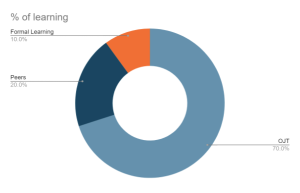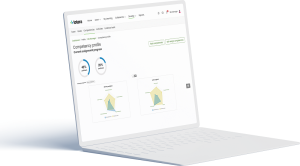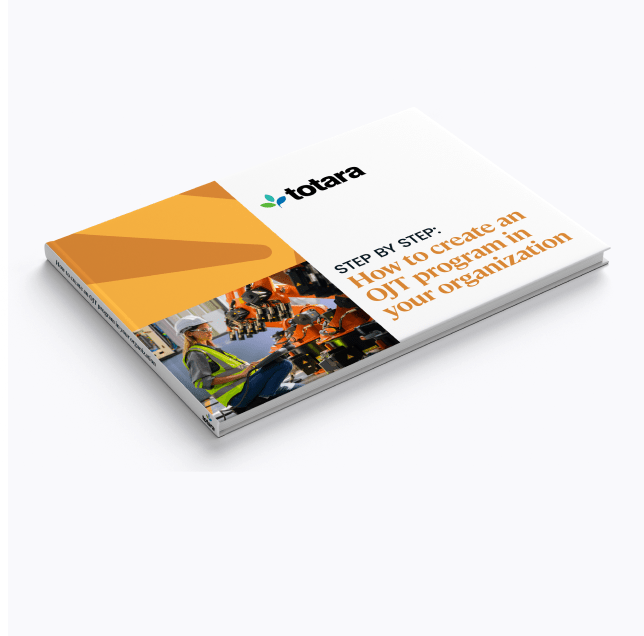On-the-job learning and evaluation (OJL) is a valuable learning approach in the workplace. It involves direct involvement and guidance from a supervisor, coworker, or professional trainer, encompassing activities such as observation, hands-on practice, and experiential learning. In this learning model, the required knowledge and skill (competency) must be demonstrated and recorded before the employee is allowed to work independently.
The demand for skilled trade professionals remains consistently high in the United States, even as a significant number of seasoned professionals are leaving the workforce. To combat this labor shortage, businesses must upskill their existing workforce efficiently and effectively, ensuring a smooth transition to fill the gaps. OJL provides a practical solution by identifying employees’ skills, offering targeted training, and aligning them with the required positions.
And a Talent Experience Platform (TXP) plays a pivotal role in administering OJL with learning courses to work in conjunction with hands-on training, competency evaluation, and continued employee performance management.
Here’s what you need to know about powering your on-the-job learning with Totara Talent Experience Platform.
The Importance of On the Job Learning
On-the-job (OJL) learning is any training received by employees in their actual workplace by a supervisor, a coworker, or a professional trainer. OJL involves observing, learning, and hands-on practice.
The 70-20-10 Model (created by McCall, Eichinger, and Lombardo) found that:
- 70% of what learners retained was related to hands-on experience and job-related skills
- Learning from co-workers and peers, coaching, and mentoring accounted for 20% of information retention
- The smallest percentage, 10%, covered was from traditional instruction with only a 10% information retention rate.

OJL also ensures that employees have the skills to perform their jobs successfully to protect them from injury and incidents. For the organizations, the cost of a workplace injury is significant both in terms of monetary value, but also from regulatory fines and time lost.
Work-related accidents account for approximately 340 million cases annually in the United States alone, which can result in significant costs for businesses. “On average, employers will spend $120,000 on each workplace injury. For companies operating at a 10% profit margin, you’ll need an additional $1.2 million in sales to pay for the injury.” – Amerisafe group
By implementing better-structured OJL programs, organizations can reduce the risk of employees getting injured on the job. Through comprehensive training and safety protocols integrated into the OJL process, employees can develop the necessary skills and awareness to minimize workplace accidents.
Numerous industries need to adhere to specific regulations, such as those imposed by the Occupational Safety and Health Administration (OSHA) or ISO Compliance standards. Structured OJL programs play a vital role in ensuring that employees are aware of and trained to comply with these industry regulations. Organizations can enhance workplace safety and minimize legal risks by incorporating compliance training into OJL.
Implementing OJL in 1-2-3
To successfully implement on-the-job learning (OJL) within your organization, a systematic approach can help streamline the process. By following the step-by-step framework outlined below, you can ensure a smooth transition to OJL and maximize its effectiveness in developing employee skills and knowledge. Let’s delve into the essential steps required for implementing OJL and creating a robust training program tailored to your company’s specific needs.
Step 1: Identify Job Competencies
The first step in implementing OJL is to identify the key competencies and skills required for each position within your company. By clearly defining the skills employees need to possess, you can create a foundation for targeted training initiatives. This involves analyzing job roles and responsibilities to determine the specific competencies that individuals should acquire and possess at different stages of their employment.
Step 2: Define Rating Scales
Once the competencies have been identified, it’s crucial to establish rating scales to measure and evaluate employee proficiency levels. These rating scales determine the expectations for each competency and can vary based on factors such as the length of time an employee has been in a particular position. By defining rating scales, you can ensure consistency in assessing employee performance and growth.
Step 3: Assign Achievement Paths
Determining how employees can demonstrate competency is a critical aspect of OJL implementation. Hands-on performance assessments are often utilized in on-the-job learning (OJL) scenarios. However, it’s essential to explore other potential avenues for employees to exhibit proficiency, such as incorporating formal learning experiences. By considering multiple ways for employees to demonstrate their skills, you create a comprehensive and flexible training environment.
Step 4: Link Job Competencies to Learning
To support employees in their competency development, it’s necessary to align the identified job competencies with relevant learning content and resources. By connecting competencies to specific training materials, employees can easily access resources that help them acquire and strengthen the required skills. This linkage ensures that training efforts are directly tied to the skills needed for success in their respective roles.
Step 5: Assign Job-Related Competencies to Employees
The final step involves assigning job-related competencies to individual employees based on their respective positions and developmental needs. By aligning competencies to employees, you create a personalized learning path for each individual. This targeted approach allows for focused skill development and enhances employee engagement and growth.
By following these systematic steps, your organization can effectively implement OJL and establish a comprehensive training program that promotes skill acquisition, performance improvement, and continuous development within your workforce.
Enhancing On-the-Job Learning with Totara TXP
Organizations can leverage learning platforms such as the Totara Talent Experience Platform (TXP) to optimize the efficiency and effectiveness of OJL programs. The integrated features of TXP, including a Learning Management System (LMS), Learning Experience Platform (LXP), and Performance Management system, make it an ideal tool for OJL implementation. Here are some key features that make TXP a powerful asset for OJL:
Dynamic Competency Assignments
TXP allows for the efficient assignment of competencies based on job roles, enabling organizations to streamline and automate the process. By aligning specific competencies with each job position, employees can progress systematically and acquire the necessary skills for their roles.
Rich Content Marketplace
With over 85,000 courses across various industries, TXP offers a vast content marketplace catering to diverse training needs. Organizations can access a wide range of learning resources to support OJL, ensuring that employees have access to relevant and up-to-date training materials.
Learning Experience Platform (LXP)
An LXP provides employees with an informal, just-in-time learning environment. It facilitates continuous coaching and mentoring from more experienced personnel, supporting the OJL process. New employees can benefit from onboarding programs, while existing staff can access resources for ongoing development and knowledge reinforcement.
Robust Reporting System
TXP offers a comprehensive reporting system, empowering organizations to track key performance indicators (KPIs) effectively. Reports can be embedded into dashboards or scheduled, allowing managers and employees to monitor progress and identify areas for improvement. The platform generates personalized skill gap reports for learners, facilitating targeted training interventions.
Personalized Skill Gap Report
Totara TXP features the Skill Gap Report – a powerful tool designed to empower every learner on their journey to success. It provides a tailored and insightful analysis that helps to identify and prioritize areas for improvement, making learning experiences more effective and efficient than ever. With its data-driven insights, actionable recommendations, and continuous tracking, you can confidently take charge of your learning, bridging the gaps and reaching new heights of proficiency and knowledge.

Multiple achievement paths
Multiple Achievement Paths – an unprecedented tool that empowers administrators to tailor learning experiences to individual learners’ unique needs, allowing them to demonstrate mastery on skills in diverse and personalized ways. By allowing administrators to create personalized, diverse, and adaptable learning journeys, we foster a community of confident and skilled learners, ready to take on real-world challenges and make a meaningful impact.
Mobile learning
Seamlessly designed to cater to your learning needs, this feature-rich app empowers learners to access a world of knowledge from any device. What sets it apart is its ability to work offline, sends push notifications, and ensures uninterrupted learning even in areas with limited connectivity.
Powering Real-World Training and Evaluations with your TXP
Observational job training plays a crucial role in addressing workforce challenges, managing risk, and ensuring regulatory compliance. By leveraging a comprehensive learning platform like the Totara Talent Experience Platform (TXP), organizations can enhance the efficiency and effectiveness of their OJL programs. With features such as dynamic competency assignments, a rich content marketplace, a learning experience platform, and robust reporting capabilities, TXP empowers businesses to create high-performing learning organizations and enable continuous development within their workforce.







